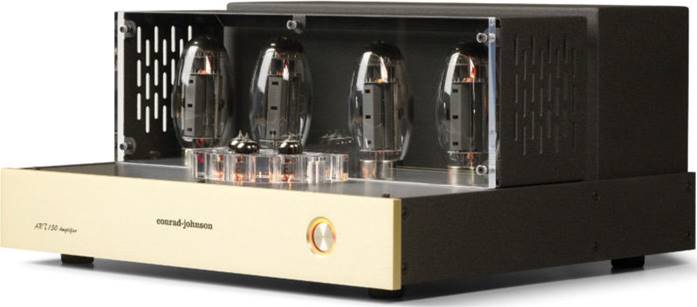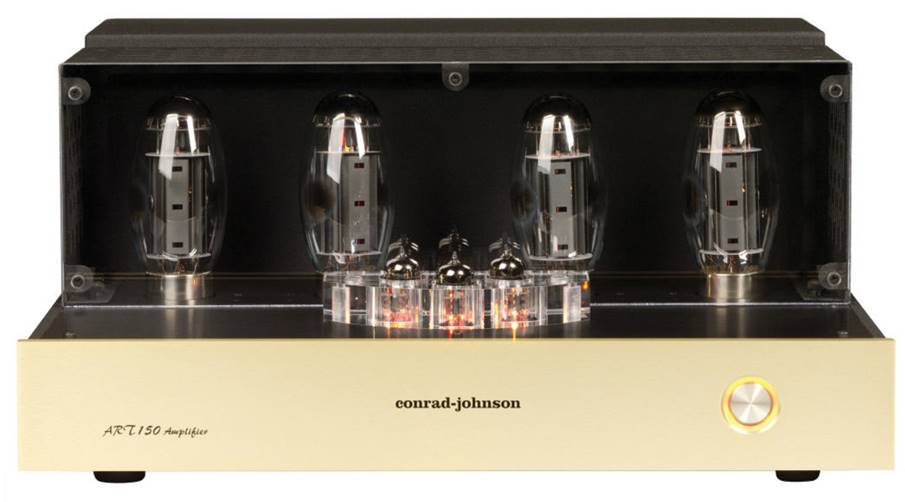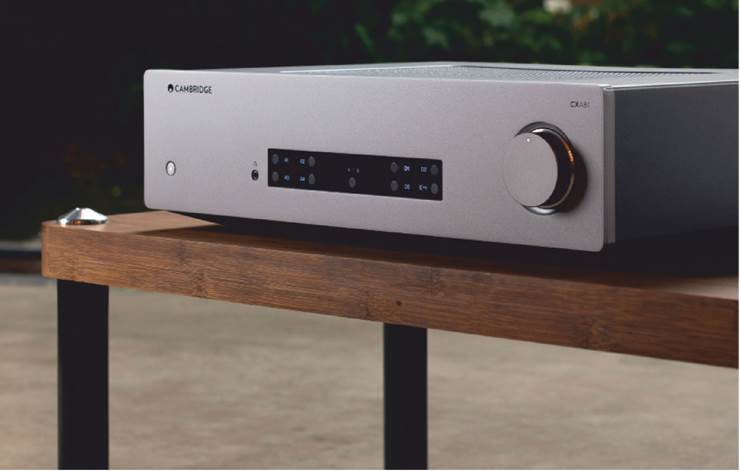Conrad-Johnson ART 150 Review: The Best of Art and Science
My experience with Conrad-Johnson goes back a long way. When I was just out of college and getting into high-end audio, Conrad-Johnson came onto the scene and was quickly recognized as one of the notable players of that first “golden age.” Founded in 1977 by Bill Conrad and Lew Johnson, “c-j”, as it’s affectionately come to be known, quickly made waves, both in the audio industry and in the pages of The Absolute Sound. While I couldn’t afford Conrad-Johnson’s gear in those days, when I got back into high- end audio in 2009 with more discretionary financial resources, “c-j” was at the top of my wish list for a new system. The first amp I bought was the venerable Premier 11A, a 70Wpc amplifier, powered by 6550 tubes. About a year later, I purchased a lightly used LP70S, a 70-watt amplifier utilizing the much newer circuit topology of c-j’s Linear Pentode Series, which was its top line of amplifiers at the time. A year after that, a friend offered to sell me his Premier 350, c-j’s legendary solid-state amp, at a price that was too good to pass up. I lived with both amps for some time, but finally decided to sell the Premier 350 to another friend and keep the LP70S. As good as the Premier 350 was, personally I found the LP70S to be more spacious, engaging, and involving. There’s just something about tube amps that really works for me.
Stephen Scharf
So, when opportunity presented itself to review c-j’s latest stereo amplifier, the ART 150, I jumped at the chance.
Design Principles: Simpler is Better
Following the Linear Pentode Series, the Anniversary Reference Triode (ART) Series, originally commemorating Conrad-Johnson’s thirtieth anniversary, debuted in 2007, and has served as the foundational basis for Conrad-Johnson’s top-line amplifiers to this day. Jonathan Valin wrote an excellent review (TAS 221) of the ART monoblocks in 2011 that provided an excellent introduction to the ART series at that time. Since, c-j has refined the line and, for its 40th anniversary, introduced a new series of amplifiers (the ART 300 monoblock and ART 150 stereo amplifier) utilizing the newer and more powerful KT150 pentode.
A long-held principle of Conrad-Johnson design is the view that simple circuits are the most effective means of achieving superior audio quality, musical involvement, reliability, and durability. These views are not exclusive to c-j; Nelson Pass shares this philosophy, and as someone who owns amplifiers from c-j and Nelson Pass, I’d have to concur. Another key principle is the use of the finest parts, such as bulk metal-foil resistors, and high-quality wire and connectors. In particular, Conrad-Johnson is well-known for being one of the first to use Teflon capacitors.
The ART 150’s circuit topology utilizes three subsystems, designed to function as simply as possible. Jeff Fischel, the designer of the ART 150 at Conrad-Johnson, can speak to the design more effectively than I can, so I’ll let him provide the design brief: “First, a voltage gain amplifier using a single triode is direct-coupled to a cathode-coupled phase inverter (each phase handled by a single triode), which in turn drives the output stage. Power is developed by KT150 output tubes, chosen for their musical accuracy, high power, and reliability. A single pair is used for each channel to comfortably and reliably achieve the 150 watts per channel power-rating of the ART 150. A small amount (about 12dB) of loop negative feedback reduces distortion and achieves a sufficiently high damping factor to control reactive loudspeaker systems. To assure continued peak performance, the owner need only make a simple bias adjustment when new tubes are installed.”
Building on the legacy of the Finear Pentode and first-generation ART amplifiers, the ART 150 has a significantly larger power supply, with twenty times the capacitance of the Linear Pentode Series and ten times the capacitance of the original ART Series. All resistors throughout are expensive, high-precision Vishay bulk metal-foil units, which significantly lower the noise floor of the ART 150 compared to previous-generation c-j amps. In addition, the regulated power supplies use MOSFETs instead of bipolar transistors, which provide increased transparency and lower impedance.
Setup and Operation
Like many c-j amps, an LED bias indicator for each tube allows the user to make a simple adjustment using the supplied tool and obviates the need for purchasing matched sets. In my long experience with c-j tube amps, once you’ve biased a pair of power tubes, you’ll rarely, if ever, have to bias them again. Conrad-Johnson amps are nothing if not reliable, and, once bias is set, operate very stably for years and years.
To keep the circuits as simple as possible, all Conrad-Johnson components are single-ended, using RCA interfaces. No balanced or XLR connections are supported. If you are also using a c-j preamp, you should know that it inverts absolute polarity, if that matters to you.

Conrad-Johnson amps are nothing if not reliable, and, once bias is set, operate very stably for years and years.
For this review, I primarily used digital music files streamed via optical fiber from a Roon music server (located in another room) to an UpTone Audio EtherRE- GEN Ethernet switch and SOtM SMS-200 UltraNeo network bridge. Alternatively, I used the Aurender N20 streamer/server with content streamed directly from the Aurender’s internal SSD (review forthcoming). A Shunyata Research Omega Ethernet cable connected the EtherREGEN to the SOtM network bridge or the Aurender, and either of these were connected to my Lampizator Baltic 3 DAC using a Shunyata Alpha USB cable. All signal, speaker, and power cables were also Shunyata Research (see associated equipment list), and components were powered by a Shunyata Everest power distributor.
Listening Impressions
One of the most common comments I get from friends and fellow audiophiles when I tell them that I use Conrad-Johnson components goes something like this: “Oh, yeah, heard their stuff years ago, enjoyable to listen to, warm and rich, but fairly colored and not the last word in neutrality.” Well, those folks haven’t listened to Conrad-Johnson’s products in some time. The old days of c-j gear sounding soft or syrupy on the top and “warm and woolly” on the low end are long gone. Listen to any c-j component made within the last 15 years or so, and you’ll have a very different experience.
Starting with the Linear Pentode Series, and now most fully realized with the ART Series of amplifiers, c-j’s core sonic attributes are outstanding neutrality, transparency, resolution, and transient speed, lifelike dynamic slam and immediacy, precise and stable imaging, three-dimensional soundstaging, lack of grain, and a low noise floor. The only other amplifiers I’ve personally heard that can compete with the ART 150 are from Technical Brain, Constellation, and DarTZeel, and those amps are many times the price of the ART 150, which speaks to its compelling value proposition.
Jon Valin specifically mentioned the lack of grain in his review of the ART monoblocks in 2011, and that attribute is fully carried over into the ART 150. With the use of very-high-quality parts (e.g., the bulk metal-foil resistors previously mentioned) throughout the entirety of the circuitry, the noise floor of the ART 150 is an impressive 10dB lower than the 30th Anniversary series of ART amplifiers that JV reviewed, and exhibits virtually no grain, burr, or “hash,” even on the quietest of today’s digital recordings.
These qualities are in full evidence on Youn Son Nah’s cover of Hurt [Lento, ACT 9030-2]. The ART 150’s lack of grain and superb midrange transparency presents the full measure of Nah’s exquisite voice, singing primarily a capella with just a solo backing guitar, portraying the pain and pathos in this ballad by Trent Reznor. Here the top end is extended, smooth, sweet in the most natural way, but not at all syrupy or soft. This track is so haunting it gave me shivers.
Carry that thought forward with respect to the ART 150’s pitch-perfect-accurate reproduction of Gustavo Santaol- lala’s guitar and backing steel guitar on “Wings,” the signature track of the Brokeback Mountain soundtrack. Here the clarity and purity of the instruments’ timbre stand in full relief against a very black and quiet background, free of any blurring or slurring of resolution, and brimming with finely articulated harmonic and textural detail.
The ART 150’s performance envelope isn’t limited to solo voice or small-scale instrumental recordings. Its ample power supply (with ten times the capacitance of the original ART Series) provides the requisite muscle to deliver the instantaneous current that takes large-scale, complex, and demanding musical passages by the scruff of the neck and shows them who’s boss. A term I’ve coined after living with big floorstanding Dynaudios for a number of years is “dynamic slam”: the ability to quickly, cleanly, and effortlessly scale from pianissimo to fortissimo, and, man, the ART 150 has sure got it.
“Asturias (Leyenda)” on Isaac Albeniz’s Suite Espanola performed by the New Phil- harmonia Orchestra [Decca, CAPC 6355 SA] is presented with such drive and immediacy that you feel you’re sitting in the orchestra rather than the audience. At the big crescendos, the brass and timpani have the speed and power of a crack of thunder; the cymbal crashes are shimmering and clean.
These attributes are also in full evidence on Gioacchino Rossini’s overture to E’Italiana in Algieri performed by Bruno Walter and the Budapest Symphony [Channel Classics CCS SA 25207]. This charming overture is representative of Rossini’s compositional style. The ART 150 handles it with aplomb and tight control, keeping the instruments in the orchestra fully resolved and delineated as the composition slowly builds complexity, intensity, and sophistication. As the orchestra cranks up to full speed for the climax, the ART 150’s superb transient speed and “fleetness of foot” effortlessly capture the dynamic slam, intensity, and playful exuberance of this wonderful overture. Delightful.
One of the notable attributes of tube amplification is imaging and soundstage reproduction, and the ART 150 excels here, also. Whether reproducing small- or large- scale content, the ART 150 recreates a precise, stable, and three-dimensionally-defined soundstage that puts you in the room with the musicians. On David Russell’s recording of Francisco Tarrega’s “Cap- pricho arabe” [Reflections of Spain: Spanish Favorites for the Guitar, Telarc 088072190863], the timbre, reverberance, and decay of Russell’s guitar, his impeccable technique, and gorgeous phrasing are presented with nuance, subtlety, and refinement. “Large-scale” imaging assignments are han-
died with equal facility. On Johnny Hodges, Soloist with Billy Strayhorn and the Orchestra [Verve 314 557 543 2]. Hodges’ gorgeous alto-sax occupies centerstage, with the various instrumental sections arrayed resplendently around him, piano on the right, trumpets on the left, drums and woodwinds at the center rear. The overall presentation is flat-out gorgeous. (This Verve Masters Edition release is a must- have for jazz aficionados, by the way, as it’s sublime.)
With respect to bass output, the old stereotype of tube amps having soft or wooly bass is no longer the sole provenance of solid-state amps. With ten to twenty times more capacitance than the original ART or LP Series amps, the ART 150 provides deep, taut, and well-defined low end. Whether it’s Ray Brown, Christian McBride, and John Clayton as a cast of cool cats playing “Mack the Knife” on Superbass [Telarc CD 83393] or E. Power Biggs’ Bach: Four Great Cantatas and Fugues [Sony Classical 92769], the ART 150 has the cojones and muscle to drive the low end with volume, power, definition, and articulation, all while keeping the bottom octaves tightly under control. This ability is particularly impressive on the Bach organ fugues, given the breadth and depth of that instrument’s tonal and dynamic range in the low end. Here the music ranges from light and airy in the midbass to solemn and grave in the lowest registers, and the ART 150 handles it without breaking a sweat.
Conclusion
Two key quality attributes that most folks never think about when considering high- end audio purchases are reliability and durability. Reliability is defined as the interval that a product will perform to specification between “service intervals.” Durability is the total “service life” of a product.
For tube amplifiers, reliability means… tube life. With my own c-j tube amps, I’ve found one can expect a set of tubes will last the average user approximately ten years. That’s excellent reliability.
In respect to durability, Conrad-Johnson’s tube amplifiers have a proven track record, with products going back the better part of 40 years still in use by their customers, and still sounding and performing beautifully. I’ll add that c-j services every product they have ever made—an additional key point to consider. While not inexpensive, when one considers that he’ll be able to enjoy the ART 150 creating engaging and involving musical experiences for ten, twenty, or even thirty years, the value proposition this wonderful amplifier provides is a “no-brainer.”
“It just sounds right” has long been a tagline for Conrad-Johnson, and that maxim certainly holds true with the ART 150 amplifier. In my all-too- short time with it, it’s gratifying to know that c-j has stayed true to both its legacy and its customers. Jeff Fishel, c-j’s
principal, tells me that the majority of Conrad-Johnson owners are repeat customers, and that makes perfect sense to me, because as someone who’s owned three of their preamplifiers and three of their amplifiers for over a decade… I’m a repeat customer myself. I love this company’s products because they just make…music.
My recommendation? Buy it, listen to it, and love it for a long time in good health. It doesn’t get any better than this.
Specs & Pricing
Power: 150 watts rms per channel from 30Hz to 15kHz, ±1.5% THD into 4 ohms (also available for 16-ohm loads) Sensitivity: 1.0V rms to rated power
Frequency response (at 10 watts): 20Hz-20kHz, ±0.25dB
Hum and noise: 108dB below rated power
Input impedance: 100k ohms
Tube complement: 3x 6922, 4x KT150
Dimensions: 19″ x 8.75″ x 16.3125″
Weight: 80 lbs.
Warranty: 3 years
CONRAD-JOHNSON DESIGN, INC.
2800K Dorr Ave. Fairfax, VA USA 22031 (703) 698-8581 conradjohnson.com
Associated Equipment
Digital sources: Aurender N20, Mac Mini Roon Core Server, Sonore OpticalModule fiber media converter, Up- tone Audio EtherREGEN Ethernet switch, Uptone Audio LPS-1.2 linear power supply
Analog source: Michell Gyro SE, SME V, Bob’s Devices Cinemag step-up transformer, Uni-Pro protractor
Phonostage: E.A.R. 324
Preamplifier: First Sound Presence Deluxe 4.0 SE MkIII-SI active preamp with Paramount Special Edition upgrade
Loudspeakers: Harbeth 40th Anniversary 30.2, Dynau- dio Contour S3.4 with Esotar 2 tweeters, REL R-305 subwoofer
Cables: Shunyata Research Sigma XC and NR V2 (Everest & power amp), Alpha NR V2 (preamp and phonostage), Shunyata Omega QR-s (DAC), V14D Digital (digital components) power cables, Shunyata Omega and Sigma interconnects, Omega Ethernet cable, Shunyata Alpha V2 VTX-Ag speaker cables, Shunyata DF-SS cable elevators
A/C power: Shunyata Research Everest 8000 power distributor and SR-Z1 wall outlet


